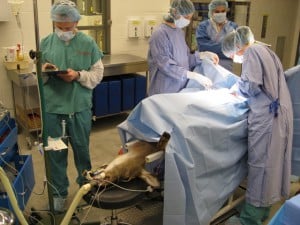Share this article
WSB study: Sterilizing female deer doesn’t reduce deer populations
Although animal welfare groups have backed sterilizing female deer — an experimental alternative to traditional methods of decreasing overabundant deer populations such as hunting or hiring sharpshooters to cull animals — wildlife biologists have argued that such efforts don’t help.
In a newly published six-year study in the Wildlife Society Bulletin, researchers found performing surgical sterilization on female deer was unsuccessful in lowering a population of overabundant deer.
“Our study does not bode well for the many well-meaning urban and suburban communities in North America experiencing negative deer impacts who wish to pursue nonlethal control techniques,” said Jason Boulanger, an assistant professor of wildlife ecology and human dimensions at the University of North Dakota and lead author. Surgical sterilization is also an expensive undertaking, costing up to $1,200, he added.
Cornell University was having deer-related problems on their 1,100-acre campus in Ithaca, N.Y., including agricultural damage and deer-vehicle collisions, which prompted administrators to fund a research study on ways to lower the number of white-tailed deer (Odocoileus virginianus) on campus. Boulanger and his team took on the study to determine the effects of surgical sterilization of female deer on the campus.
To capture the adult female deer for the sterilization procedure, a group of two to five field staff, including co-author Paul Curtis of Cornell University, wildlife undergraduate volunteers, a wildlife technician, and Boulanger used dart rifles to immobilize the animals.
The darts, which were filled with a drug combination that takes about 10 minutes to take effect, also contained a very small radio-transmitter to help the researchers locate the deer in the field after the procedure. The team placed the tranquilized deer on a stretcher, covered it with a blanket and put it on a pickup truck to take the animal to Cornell University’s Hospital for Animals for the sterilization surgery. They also trapped some deer in drop-door netted cages, collapsible traps with an aluminum frame and fabric netting around all sides, baited with apples and corn.
The researchers looked at two types of surgical sterilization: tubal ligation, or tying the fallopian tubes, and ovariectomy, or removing the ovaries. After the surgeries, the researchers put radio-collars on the deer and placed ear tags on both of their ears before releasing the animals in the general area where they were captured. They then monitored the adult deer’s movements, home ranges, and fawning rates in order to determine the effectiveness of the surgery.
In comparison to 27 control deer, the 93 sterilized deer were indeed less likely to have fawns. None of the deer that were sterilized by ovariectomy produced fawns, but three with tubal ligations gave birth.

Veterinary surgeons perform a sterilization procedure on a white-tailed deer caught on Cornell University’s campus. ©Jason Boulanger
Boulanger and his colleagues also looked at population numbers throughout the study by studying camera trap photos of deer in the area to determine mark-recapture population estimates. In general, they found there was no decrease in deer population size on the campus over the six-year period. This surprised the team because by the third year of the study, the researchers had difficulty spotting fawns on campus. However, after reviewing the camera data, they determined there was a 38 percent decrease in sightings of adult females, a 79 percent decrease fawns, but an 873 percent increase in adult males. The authors hypothesized that the large number of adult male deer might be the result of continued estrus cycling until late winter or early spring in the female deer treated with tubal ligation. These females, the researchers suggest, attract more adult male deer to the campus.
Further, the team noted that impacts of deer on the campus, including damage to vegetation and vehicle accidents, continued throughout the study regardless of the number of sterilized female deer. For example, Cornell University police did not see a reduction of vehicle accidents during the study.
Implementing lethal control
Boulanger says the results of the study convinced the Cornell administrators that surgical sterilization was not a solution to curbing the number of deer on the campus. “We were still having problems with deer impacting the campus, and we had their permission to implement lethal control efforts as part of the overall study program,” he said. These lethal control methods included implementation of deer damage permits issued by the state wildlife agency in March 2013, as well as deer trapping and euthanasia via captive bolt in 2014. With these lethal measures, the team reduced the deer numbers by almost half in just a year’s time on the core campus of Cornell, Boulangers says.
In communities that prefer nonlethal methods of reducing deer populations, he recommends ovariectomy surgery to avoid the possibilities of failed surgeries and increased numbers of males that are attracted to female deer that continue to go into estrus. But Boulanger says it is unknown whether this can be a successful stand-alone technique in areas of chronic deer overabundance.
“Given current deer-control technology, we agree with the recent position statement by the Northeast Section of The Wildlife Society on managing chronically overabundant deer that lethal removal via regulated hunting or shooting currently remains the most effective management option for mitigating negative deer impacts,” Boulanger concluded.
Header Image: Three white-tailed deer stand in the snow. Recent research on Cornell University’s campus showed surgical sterilization of deer did not lower deer population numbers over a six-year study. ©Conrad Kulper








